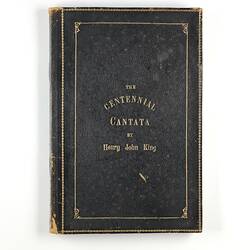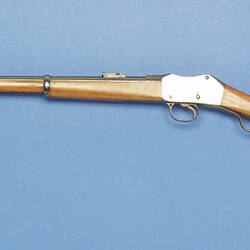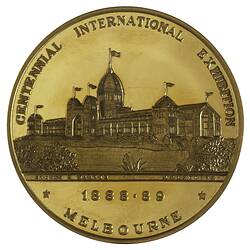Summary
Coloured printed certificate presented to Miss A.J. Power, 'In recognition of valuable services rendered as a Member of the Centennial Choir during the currency of the Centennial International Exhibition, Melbourne, 1888', printed by the Melbourne lithographic firm, McCarron, Bird & Co.
Physical Description
Coloured printed certificate presented to Miss A.J.Power 'In recognition of valuable services rendered as a Member of the Centennial Choir during the currency of the Centennial International Exhibition, Melbourne, 1888'. The certificate, printed by McCarron, Bird & Co., Lithographers of Melbourne, is in shades of yellow, brown, blue, green, pink and white on a cream background. There is a border of yellow, brown and blue, with green and white stylised flowers. At the top left corner is an illustration of the Exhibition Building, from Nicholson Street, showing a cable tram and horse drawn vehicles. Below on a scroll is a list of the choral works sung by the Centennial Choir, including 'Messiah, Creation, Elijah, Choral Symphony, Stabat Mater, Ruth, Golden Legend, Song of Thanksgiving, Centennial Cantata, Gallja, Choral Fantasia and Sleeping Beauty'. There is also a coloured etching of the choir (over 700 voices strong) standing in front of the organ on the mezannine of the Great Hall, above the legend 'Marvellous Sweet Music - Shakespeare'. The certificate is signed by Geo. T. Lavater, Secretary; E. Miller, Music Business Manager, J. MacBain[?], President; F. T. Sargood, Executive Vice President, and Frederic H. Cowen, Musical Director and Conductor. The scroll is against a stylised decoration of white roses and wattle, and there is also a design of musical instruments (violin, horn and windpipes, with a score). The certificate is surrounded by an embossed heavy card frame in shades of green and brown with a decoration of flowers.
Significance
This was Lot 949 at the Nobles Numismatics Auction on 26 July 2005, in Melbourne.
The 1888-89 Centennial Exhibition was accompanied by an amazing musical festival, under the direction of an English conductor, Frederick Cowen, who was paid an astonishing 5000 pounds for six months work. He formed an orchestra and a choir of over seven hundred voices, that gave over 260 concerts - ten concerts a week. The western transept of the Great Hall was converted to a concert hall with a false ceiling and moveable partitioning. Before the Exhibition, orchestral work had been almost unknown in Melbourne, and the musical programme was thus exciting and eye-opening. Cowen gradually introduced modern pieces to the Melbourne audience, and succeeded in expanding the city's musical taste. A poll towards the end of the series of concerts listed the most popular works: Beethoven's Pastoral Symphony, Wagner's overtures for Tannhauser and Rienzi, Handel's 'Largo', and Liszt's 'Hungarian Rhapsody Number 1'. Each member of the choir had his or her own copies of the scores, and certificates like this were presented to choir members at the end of the season.
More Information
-
Collection Names
-
Collecting Areas
-
Acquisition Information
Purchase
-
Person Named
Miss A J. Power, Melbourne, Greater Melbourne, Victoria, Australia, 1889
-
Lithographer
McCarron, Bird & Co., Melbourne, Greater Melbourne, Victoria, Australia, 1889
-
Person Named
Sir Frederic H. Cowen, Melbourne, Greater Melbourne, Victoria, Australia, 1889
-
Person Named
Sir Frederick Thomas Sargood, Melbourne, Greater Melbourne, Victoria, Australia, 1889
-
Person Named
George T. Lavater, Melbourne, Greater Melbourne, Victoria, Australia, 1889
-
Person Named
Mr E Miller - Centennial Exhibition Choir, Melbourne, Greater Melbourne, Victoria, Australia, 1889
-
Inscriptions
To Miss A. J. Power/ In recognition of valuable services/ rendered as a Member of/ The Centennial Choir/ during the currency of the/ Centennial International/ Exhibition, Melbourne 1888.
-
Classification
Public events, Melbourne centennial exhibition 1888, Certificates
-
Category
-
Discipline
-
Type of item
-
Overall Dimensions
59 cm (Length), 48.7 cm (Width), 0.5 cm (Height)
-
References
See David Dunstan: Victorian Icon: the Royal Exhibition Building, Melbourne, and REB Research files for more information about the choral concerts given by the Centennial Choir.
-
Keywords
Exhibitions, Exhibitions: Melbourne International Centennial, 1888-1889, Music, Musical Performances




